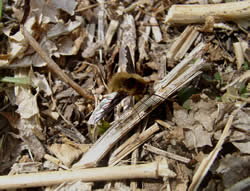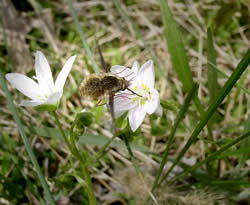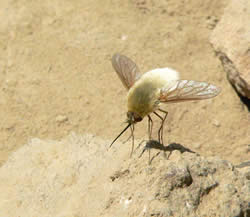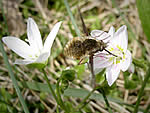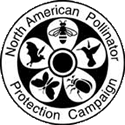USDA Forest Service Celebrating Wildflowers
|
|
|
Bee Flies (Bombylius spp.), A Pollinator with a Bad Reputation
By Beatriz Moisset Early, in the spring it is easy to see some furry insects flying and hovering just above ground. These are flies of the genus Bombylius, members of a large family of flies, Bombyliidae, known as bee flies. Bombylius flies are widely distributed in the northern hemisphere; they are found in North America as well as in Europe and Asia. They are among the many flies that imitate bees, bumblebees in this case, and this is how they got both their common and their scientific name. Like some bumblebees they are brown and furry and they make a buzzing sound when flying. But unlike them they have only two wings instead of four, large eyes, skinny long legs and very short antennae, not at all like those of bees. They are prodigious fliers that can hover in midair, move very fast and maneuver with great skill, changing directions in the blink of an eye. They possess a stiff and long tongue, or proboscis, which they use for probing into flowers to sip their nectar while hovering in front of them. By not landing on the flower they seem to try to avoid the predators that may be hiding in them, such as crab spiders or ambush bugs. Despite barely touching the flowers some pollen sticks to their furry coat and is easily transported to other flowers. They are visitors of some early spring flowers such as spring beauty, Claytonia virginica, the same flowers that are visited by some bees such as Andrena. They are just as efficient pollinators of these flowers as are the bees and they are more frequent visitors so, all and all, they probably pollinate more flowers than these bees. However there is a dark side to this pollinator. The reason why it diligently hovers over bare ground early in the spring is that it is looking for bee nests, probably the same ones with which they compete for nectar. The bees dig tunnels and lay their eggs at their bottoms after collecting enough pollen to feed the larvae. This requires numerous trips, thus the bee fly takes advantage of the mother’s absence and lays its eggs in such nests. Making use of its flying prowess, it does not even need to land but it flicks its abdomen while hovering over the open burrow, letting one egg fall in or near it. The fly larva finds its way to the chamber where the mother bee has laid the provisions and the egg and proceeds to feed on the stored pollen. Afterwards it devours the bee larvae; when it is fully grown, it pupates and stays inside the nest until next spring. For Additional Information
|
|
| NOTE: PDF format links require the Adobe Acrobat Reader to view. | |
| top | Disclaimers | FOIA | Privacy Policy | Quality of Information | Photo Credits & Use |
Location: http://www.fs.fed.us/wildflowers/pollinators/pollinator-of-the-month/bee_flies.shtml
Last modified: Friday, 29-Aug-2008 15:13:35 EDT
